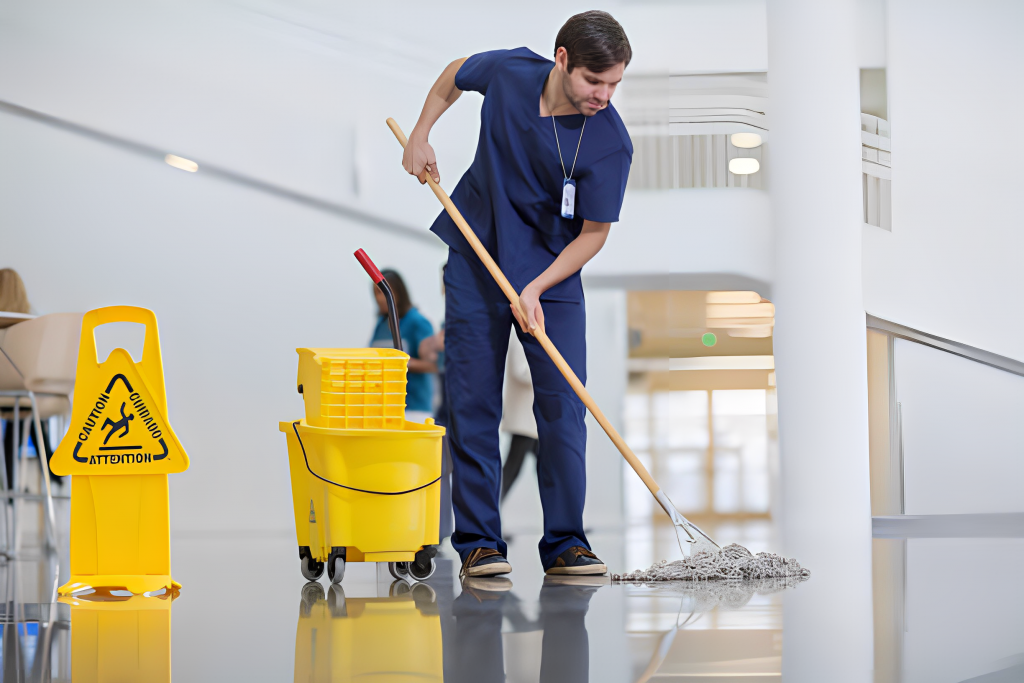Why Deep Cleaning Hardwood Floors Is Important
Deep cleaning hardwood floors is about restoring their natural shine and beauty. Over time, regular cleaning might miss dirt and grime that accumulate in the grain and seams of the wood. When you deep clean your hardwood floors, you can remove hidden contaminants that might be causing damage. Maintaining your floors’ original color and texture becomes more accessible with this solution’s help. Additionally, it can prevent general wear and tear caused by debris and moisture, which can ultimately extend the lifespan of your floors. Beyond aesthetics, deep cleaning has health benefits. Dirty floors can harbor allergens, bacteria, and mold, affecting indoor air quality. Deep cleaning helps eliminate these health hazards, creating a cleaner and healthier home environment. Additionally, well-maintained hardwood floors can increase the value of your home, making regular deep cleaning an investment that pays off in property value and market appeal. Click here to learn more about professional floor cleaning services.Hardwood Floor Types
Understanding the types of hardwood floors is essential when planning a deep cleaning routine. Hardwood comes in many forms, each with unique characteristics and cleaning requirements. The most common types are solid hardwood, engineered hardwood, prefinished hardwood, reclaimed wood, exotic hardwood, and distressed wood. Each type has its own advantages and cleaning considerations.Solid Hardwood Floors
Solid hardwood floors offer a timeless and natural appearance, as they are made from a single piece of wood, providing strength and durability. They are a popular choice because they can be sanded and refinished multiple times, which helps to extend their lifespan. Common wood species for solid hardwood include oak, maple, and cherry, each with distinct grain patterns and hues. This type of hardwood offers unparalleled resilience, making it a popular choice for many homeowners.Prefinished Hardwood Floors
Prefinished hardwood floors are finished in a factory before installation and are ready to be installed without additional sanding or finishing. This convenience factor makes prefinished hardwood popular among homeowners looking to save time and avoid the mess of on-site finishing. These floors are available in various styles, finishes, and wood species, allowing for greater customization. Additionally, prefinished hardwood requires less maintenance than unfinished alternatives, making it a practical choice for busy households.Engineered Hardwood Floors
Engineered hardwood floors are designed with a top layer of natural wood veneer over multiple layers of plywood or composite materials. This construction gives them stability and resistance to environmental changes like humidity and temperature fluctuations. Engineered hardwood floors can be used as underfloor heating systems and offer versatility for finishes, textures, and wood species. These features make engineered hardwood an excellent choice for areas prone to temperature variations.Equipment Used For Floor Cleaning
Deep cleaning hardwood floors requires specific equipment to ensure thorough cleaning without damaging the wood. Essential tools include a broom, vacuum, microfiber mop, hardwood floor cleaner, bucket, and optional tools for specific cleaning needs.Dust Mop
A dust mop is an important tool for removing surface dirt and debris. Its long handle and soft, fluffy fibers make it ideal for sweeping hardwood floors without scratching the surface. Dust mops are great for everyday use and help maintain a clean surface before deeper cleaning tasks.Vacuum
Vacuuming is crucial for reaching tight spaces and corners where dust and debris accumulate. A soft brush attachment vacuum is recommended to prevent scratching the hardwood surface. This tool is ideal for more thorough cleaning, especially in areas that are hard to reach with a dust mop.Wet Mop With A Cleaning Pad
A wet mop with a cleaning pad is needed to tackle stains and spills during deep cleaning. By dampening the cleaning pad with water and using a hardwood floor cleaner, you can effectively clean without using excessive water, which could damage the hardwood. Wet mops are helpful for deep cleaning tasks and ensure a gentle yet thorough cleaning process.Hardwood Floor Cleaner
Opting for the best hardwood floor cleaner is essential for deep cleaning. A pH-balanced cleaner is recommended to protect the floor’s finish while effectively removing dirt and grime. Harsh chemicals can damage the wood, so selecting a cleaner designed for hardwood floors is essential.Microfiber Cloths
Microfiber cloths help buff and achieve a streak-free shine after deep cleaning. They are gentle yet effective, making them ideal for hardwood floors. Microfiber cloths also wipe up spills and ensure a smooth finish.Putty Knife
A putty knife can remove stubborn stains and residue from hardwood floors. Using a putty knife gently is essential to avoid damaging the wood surface. This tool is helpful for spot cleaning and tackling tougher stains that require a bit more effort to remove.Mineral Oil
Mineral oil is beneficial for nourishing and protecting hardwood floors. Applying mineral oil with a clean cloth in circular motions can add a soft glow and prevent it from drying out or cracking. This step is beneficial for maintaining the beauty and longevity of hardwood floors.Steps For Deeply Cleaning Hardwood Floors
Deep cleaning of hardwood floors involves several steps, from gathering supplies to drying the floors thoroughly. The following guide outlines each step to ensure a thorough and effective deep cleaning process.Sweeping Or Dusting The Floor
First of all, we need to remove loose debris from the floor. Sweeping or dusting with a broom or dust mop helps clear the surface of dirt, dust, and pet hair. This step ensures the floor is free from larger particles that could cause scratches during the more profound cleaning process.Vacuuming The Floor
Vacuuming follows sweeping to remove all debris from tight spaces and corners. Use a soft brush attachment vacuum to avoid scratching the hardwood surface. This step is essential for deeper cleaning and preparing the floor for mopping.Choosing The Right Cleaning Solution
Selecting a suitable cleaning solution is crucial for deep cleaning hardwood floors. A pH-neutral cleaner for hardwood floors is recommended to avoid damaging the wood. Choosing the right product depends on the type of hardwood and any specific cleaning requirements. Be sure to read labels carefully to ensure compatibility with your floor type.Mixing A Homemade Cleaning Solution
If you prefer a natural approach, mix a homemade cleaning solution using simple ingredients like water and mild dish soap or vinegar. This eco-friendly option is gentle on hardwood and can be as effective as commercial cleaners. Ensure you follow the correct proportions to avoid damaging the floor, and remember to use only a tiny cleaning solution to prevent water damage.Testing The Cleaning Solution On A Small Area
Conducting a patch test on an inconspicuous area before using the cleaning solution on the whole floor is crucial. This step ensures that the solution won’t damage or discolor the wood. Apply a small amount of the solution and wait a few minutes before checking for any adverse reactions. If the test area remains intact, you can proceed with confidence.Mopping The Floor With A Cleaning Solution
After testing the cleaning solution, you can begin mopping the hardwood floors. Depending on your preferred method, dip the mop into the solution or spray it directly onto the floor. Be sure to wring out excess liquid to avoid soaking the hardwood, and mop toward the wood grain to prevent streaking or uneven cleaning.Removing Tough Stains
If you encounter stubborn stains during mopping, use gentle blotting techniques and suitable cleaning solutions. Avoid abrasive methods, as they could damage the wood. A putty knife can scrape away stubborn residue, but it must be used carefully to avoid scratches or gouges. This step demands patience and a gentle touch to ensure the hardwood remains undamaged.Drying The Floor
After mopping, thoroughly dry the floor to prevent warping or mold growth. You may accelerate drying by utilizing fans or opening windows to increase airflow. This step is essential for avoiding moisture-related damage, so dry the floors completely before placing furniture on them or walking on them.Tips For Maintaining Clean Hardwood Floors
Maintaining clean hardwood floors requires ongoing care and attention. The following tips can help keep your floors in the best condition and decrease the need for frequent deep cleaning.Regular Dusting And Sweeping
Regular dusting and sweeping are essential to prevent scratches and maintain cleanliness. Incorporate this step into your weekly cleaning routine to keep dirt and debris from building up on the floor. Use a broom or a microfiber mop for gentle yet effective cleaning.Using Floor Mats And Protectors
Floor mats and protectors play a crucial role in trapping dirt and moisture, preventing damage to the hardwood. Place mats at entryways to catch debris from shoes, and use felt pads on furniture legs to avoid scratches. These simple precautions can help preserve the appearance and longevity of your hardwood floors.Avoiding Excessive Water Exposure
Excessive water exposure is a common cause of damage to hardwood floors, leading to warping and mold growth. Avoid soaking the floors with water, and use a slightly damp mop for cleaning. After mopping, ensure the floor is thoroughly dried to prevent moisture-related issues.Applying A Fresh Coat Of Finish
Applying a fresh coat of finish adds protection and enhances the appearance of hardwood floors. This step helps prevent wear and tear while maintaining a polished look. The process involves recoating the floors, and the type of finish—oil-based or water-based—depends on personal preference and floor compatibility.Revitalize Your Hardwood Floors With Green Clean Janitorial!
With Green Clean Janitorial, you can trust that your hardwood floors are in good hands. Our professionals are trained to clean and maintain hardwood floors, ensuring longevity and beauty. We also use eco-friendly cleaning products, providing a safe and healthy environment for you and your family. Don’t let everyday wear and tear diminish the appearance of your hardwood floors. Consider professional floor care services for high-traffic areas or if your floors have significant wear and tear. Contact us for eco-friendly, safe, and effective hardwood floor cleaning solutions.FAQs
A vinegar and water solution is effective for deep cleaning hardwood floors, gently lifting dirt and grime without leaving residue or damaging the finish. Combine equal parts vinegar and water, mop the floors, and dry them promptly to maintain their shine and integrity.
A mixture of warm water and mild dish soap is ideal for removing buildup on hardwood floors; apply with a damp mop and gently scrub stubborn areas, then rinse with clean water and dry thoroughly. Avoid harsh chemicals or abrasives to prevent damage to the wood finish.
Sweep or vacuum regularly to remove debris, then use a damp mop with a gentle cleaning solution like vinegar and water, ensuring the floor dries quickly to maintain its luster and prevent water damage.
Professionals often use specialized equipment like microfiber mops and professional-grade cleaners to deep clean wood floors efficiently, ensuring thorough removal of dirt and grime while protecting the floor’s finish. They follow manufacturer guidelines and may employ techniques like buffing or polishing for a pristine result.




